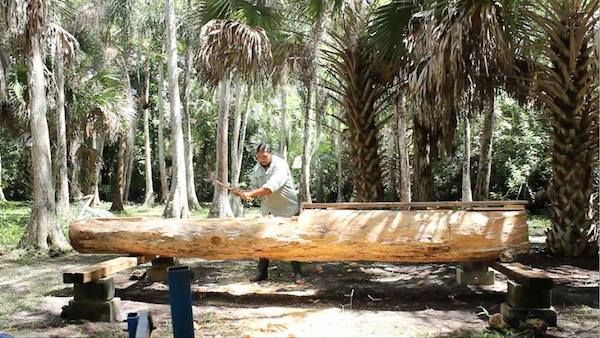
Canoe demonstration project preserves American Indian tradition
By Robin Haines Merrill, Upper Room Art Gallery Tonight in Fort Lauderdale, the Upper Room Art Gallery will kick off a yearlong public art project centered around the traditional art of creating dugout canoes. Below, the gallery’s Robin Haines Merrill writes about the project and the importance of keeping the art alive.
I’m not a native Floridian, but in the past few years I’ve had the privilege to get to know some of the real natives in the Seminole and Miccosukee Tribes. When I invited a few of them to be daring and participate in a public performance art piece I staged in Fort Lauderdale in 2012 using a dugout canoe on the New River, this was the first response: “You know we drive SUV’s now, right?”
I hadn’t realized that most of the skills to even navigate a canoe have been lost, let alone the fact that very few functioning canoes exist. There is a certain rhythm, timing and natural balance that comes with any vehicle or transportation device, such as riding a bike. Without practice, skills can become rusty, or even lost. But what became more intriguing to me as an artist is the craftsmanship involved in creating a Florida dugout canoe from a cypress log, and how this craft needs to be passed down and witnessed from generation to generation to keep it from becoming extinct.
Craftsmanship is important to every generation, every culture, in every time period. Even if we’re not aware of it, there is a deep inner healing that can take place from just stopping our daily survival motions and engaging in the most simple and rudimentary skills, such as weaving, sewing, drawing or carving.
Yet two factors weigh heavy against the survival of the canoe crafting tradition: Canoes are no longer needed for transportation and Florida’s cypress trees are no longer growing as big to handle a canoe being carved from it. The big old trees are mostly in protected preserves. Changes in South Florida’s water flow have diminished the large, old tree population.
Over the coming year, traditional Seminole artist Pedro O. Zepeda will carve a dugout canoe from a cypress log inside the Upper Room Art Gallery in downtown Fort Lauderdale. The gallery is situated in the exact spot that his ancestors came to trade along the New River, bringing goods from far-reaching locations in the Everglades. The Stranahan House, a trading post along the river, is now a museum and partners with our Tribal Arts Project.
Aside from the actual canoe carving within the gallery, an annual water-based event will be held on the Himmarshee Canal, a tributary of the New River that cuts through the heart of Old Fort Lauderdale along Las Olas Boulevard. Unknown to most urbanites, a gorgeous environmental treasure called the Himmarshee Canal still exists and is far from a drainage ditch. Its banks are filled with mangroves, hawks, sea grapes and soon, a public art performance piece titled “Paddle Up on the Himmarshee Canal.”
We are grateful to Knight Foundation for generously planting the seed money to see this project come to fruition.
Art Basel Miami has invited the world to come to South Florida for over a decade to view art, but South Florida’s own art scene has sadly been void of indigenous tribal art. I hope that the Tribal Arts Project will be a platform where local tribal members feel comfortable with interacting on a global stage, in this cultural fusion.
The event begins at 7 p.m. at the gallery, Las Olas Riverfront, 300 SW First Ave., No. 124. The project is a winner of the South Florida Knight Arts Challenge, which is now accepting applications.
Recent Content
-
Artsarticle ·
-
Artsarticle ·
-
Artsarticle ·
